Articles
- Page Path
- HOME > Korean J Community Nutr > Volume 17(4); 2012 > Article
-
Original Article
- Effects of Fusion-Food Cooking Activity on Elementary School Students' Knowledge, Preferences and Perceptions of Korean Traditional Foods
- Jeong-Hae Bae, Kyoung Ae Lee
-
Korean Journal of Community Nutrition 2012;17(4):376-389.
DOI: https://doi.org/10.5720/kjcn.2012.17.4.376
Published online: August 31, 2012
Busan Haegang Elementary School, Busan, Korea.
1Department of Practical Arts Education and Centre for Child Nutrition Education, Busan National University of Education, Busan, Korea.
- Corresponding author: Kyoung Ae Lee, Department of Practical Arts Education, Busan National University of Education, 24(Geoje-dong) Gyodae-gil, Yeonje-gu, Busan 611-736, Korea. Tel: (051) 500-7285, Fax: (051) 500-7281, kalee@bnue.ac.kr
Copyright © 2012 The Korean Society of Community Nutrition
- 942 Views
- 3 Download
- 1 Crossref
Abstract
- The purpose of this study was to develop a fusion-food cooking program and apply that to sixth grade elementary school students, and to investigate its' effects on their knowledge, preferences, and perceptions of Korean traditional foods. The program focused on ten components. Students learned the general features of Korean traditional foods and Western foods in the 1st lesson. They learnt about kinds, nutrition value, and histories of kimchi, Tteok (rice cake), and Jeon (pan fried food), and cooked two fusion-foods of kimchi, Tteok, and Jeon each. As a result of learning about those food items, the students advanced their knowledge (p < 0.001) of kimchi, Tteok, and Jeon. Their preferences for Tteok (p < 0.05) and Jeon (p < 0.01) were increased, but those for kimchi remained unchanged. The interest (p < 0.05) and preferences (p < 0.01) for the general Korean traditional foods were increased. In conclusion, our results suggested that the fusion-food cooking program had the ability to improve elementary school students' perceptions of Korean traditional foods by increasing their knowledge, preferences, and interest in them. Furthermore it was considered that the program could help students understand the value of Korean traditional foods and in turn may encourage them to consume such food items more frequently. Since the fusion-food cooking activity program can be a good learning program as shown by the results of this study, more fusion-foods cooking activity programs, which are not discussed in this study, should be evaluated and developed in the future.
- 1. Bae HU. Nutrition habit of elementary school students and preference realities of traditional food. 2005; Daegu National University of Education; Master's degree Dissertation.
- 2. Cha JA, Yang IS, Lee SY, Chung L. Effect - evaluation of Korean traditional culture education program for elementary schoolers. Korean J Food Cult. 2007; 22(4): 383-392.
- 3. Choi MS, Jung EH, Hyun TS. Perception and preference of Korean traditional foods by elementary school students in Chungbuk province. Korean J Diet Cult. 2002; 17(4): 399-410.
- 4. Chung HJ. Present condition and future prospect of fusion food. Korean J Culinary Res. 2001; 7(3): 99-109.
- 5. Kang IH. Korean dietary history. 1993; Seoul: Samyung Co.
- 6. Kang JH, Lee KA. The perception, preferences, and intake of Korean traditional foods of elementary school students -Focusing on kimchi, tteok and eumcheong varieties-. Korean J Food Cult. 2008; 23(5): 543-555.
- 7. Kim JM. The effect of cooking activities on the unbalanced diet of young children. J Res Ins Curriculum Instr. 2002; 7(1): 121-139.
- 8. Kim JS. Universalizing Korean foods. Korean J Food Cult. 2005; 20(5): 499-507.
- 9. Kim KA. A study on the teaching materials for the traditional foods culture education in elementary school. 2003; Seoul National University of Education; Master's degree Dissertation.
- 10. Ko KM. Action research on the operation of cooking activities to improve young children's picky eating. 2012; Ewha Womans University; Master's degree Dissertation.
- 11. Kwak YJ, Kim HJ. A study on the perception of the Korean traditional foods among fifth and sixth grade elementary school students for the preperation of globalization. J Korean Pract Arts Educ. 2009; 15(1): 149-174.
- 12. Lee HB, Yang MH. The effects of the cooking activities in kindergarden on the ingesting level of disliked food and the inappropriate eating behaviors of children. J Dev Disabil. 2009; 13(2): 77-100.
- 13. Lee KA. Activity-based nutrition education for elementary school student. Korean J Nutr. 2003; 36: 405-417.
- 14. Lee MY, Kim YA. The perception and utilization of Korean traditional food and fast food of elementary school children in Ansan area. J Korean Home Econ Assoc. 2006; 44(10): 109-120.
- 15. Lee SH. A study on ways to prevent obesity among elementary school students through a cooking activity program designed to improve eating habits. 2009; Korea National Sport University; Master's degree Dissertation.
- 16. Ministry of Education & Human Resources Development. Elementary Practical Arts. 2002a; 6th grade. Seoul: Daehan textbook Co.; 30-53.
- 17. Ministry of Education & Human Resources Development. Teaching guide to Elementary Practical Arts. 2002b; 6th grade. Seoul: Daehan textbook Co.; 72-99.
- 18. Ro HK, Park J. Grade and gender differences in dietary behavior, food preference and perception about the body image of 4, 5, and 6th grade students in elementary school. Korean J Diet Cult. 2001; 16(2): 158-169.
- 19. Seo JY, Choi BS, Lee IS. Effects of nutritional education featuring cooking activities on preschool children in Daegu area: Food habit and dietary attitude. J East Asian Soc Diet Life. 2010; 20(5): 794-801.
- 20. Yang JH. The effectiveness of after-school progaram in practical arts education on the change of disabled children toward dietary attitude. J Elementary Educ. 2010; 23(1): 163-182.
- 21. Yu KH. A program of practical nutrition education by cooking activities. Ulsan College, J Res. 2004; 31(1): 67-76.
REFERENCES
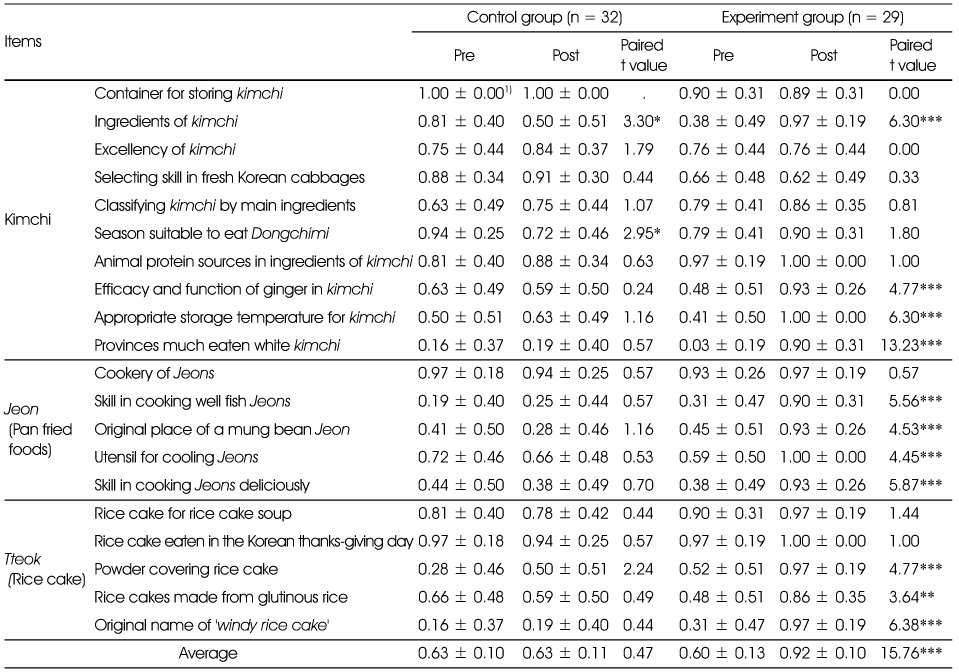

Figure & Data
REFERENCES
Citations

- Traditional Food Consumption and Cultural Food Knowledge in Korean and Japanese Elementary School Students
Jiyu Choi, Sooyoun Kwon, Sang-Jin Chung
The Korean Journal of Food And Nutrition.2016; 29(2): 218. CrossRef
Cooking activity program based on fusion-foods(Fusion-food cooking program)
General characteristics of subjects
1) N (%), *: p < 0.05
Pretest results of knowledge and preferences for Kimchi, Tteok and Jeon
1) Mean ± SD (Correct answer: 1, Wrong answer: 0)
2) Mean ± SD (Like greatly: 5, like: 4, moderate: 3, dislike: 2, dislike greatly: 1)
Pretest results of interest and preference for the general Korean traditional foods
1) N (%), *: p < 0.05, **: p < 0.01
Pretest results of perceptions of the general Korean traditional foods
1) N (%)
Effects of the fusion-foods cooking program on the children's knowledge of Kimchi, Tteok, and Jeon
1) Mean ± SD (Correct answer: 1, Wrong answer: 0)
*: p < 0.05, **: p < 0.01, ***: p < 0.001
Effects of the fusion-foods cooking program on the children's preferences for Kimchi, Tteok, and Jeon
1) Mean ± SD (Like greatly: 5, like: 4, moderate: 3, dislike: 2, dislike greatly: 1)
*: p < 0.05, **: p < 0.01, ***: p < 0.001
Effects of the fusion-foods cooking program on the children' interest and preference for the general Korean traditional foods
1) N (%), *: p < 0.05, **: p < 0.01
Effects of the fusion-foods cooking program on the children' perceptions of the general Korean traditional foods
1) N (%)
1) N (%), *: p < 0.05
1) Mean ± SD (Correct answer: 1, Wrong answer: 0) 2) Mean ± SD (Like greatly: 5, like: 4, moderate: 3, dislike: 2, dislike greatly: 1)
1) N (%), *: p < 0.05, **: p < 0.01
1) N (%)
1) Mean ± SD (Correct answer: 1, Wrong answer: 0) *: p < 0.05, **: p < 0.01, ***: p < 0.001
1) Mean ± SD (Like greatly: 5, like: 4, moderate: 3, dislike: 2, dislike greatly: 1) *: p < 0.05, **: p < 0.01, ***: p < 0.001
1) N (%), *: p < 0.05, **: p < 0.01
1) N (%)

 KSCN
KSCN
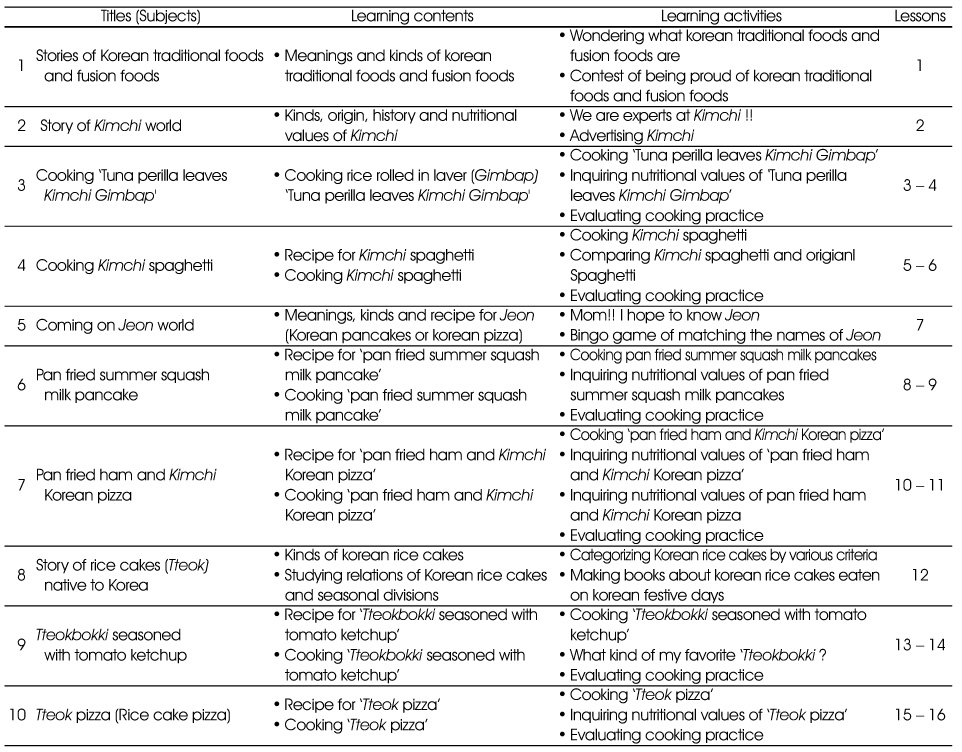
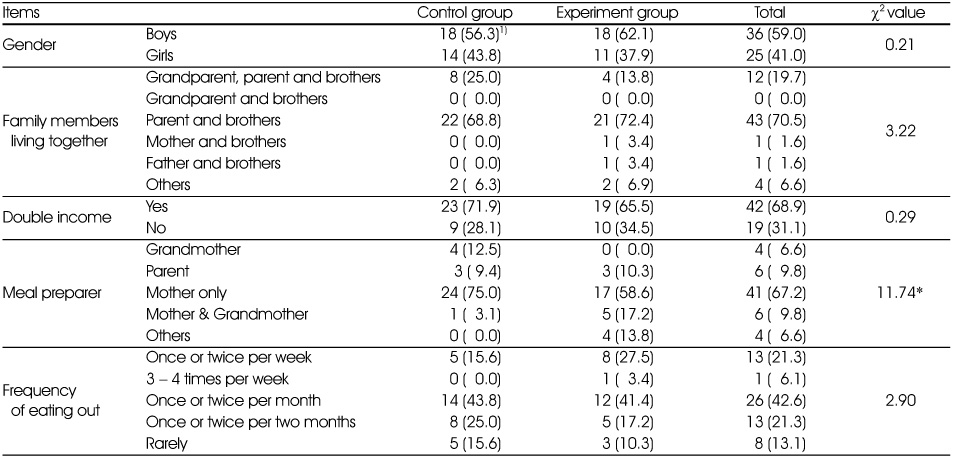

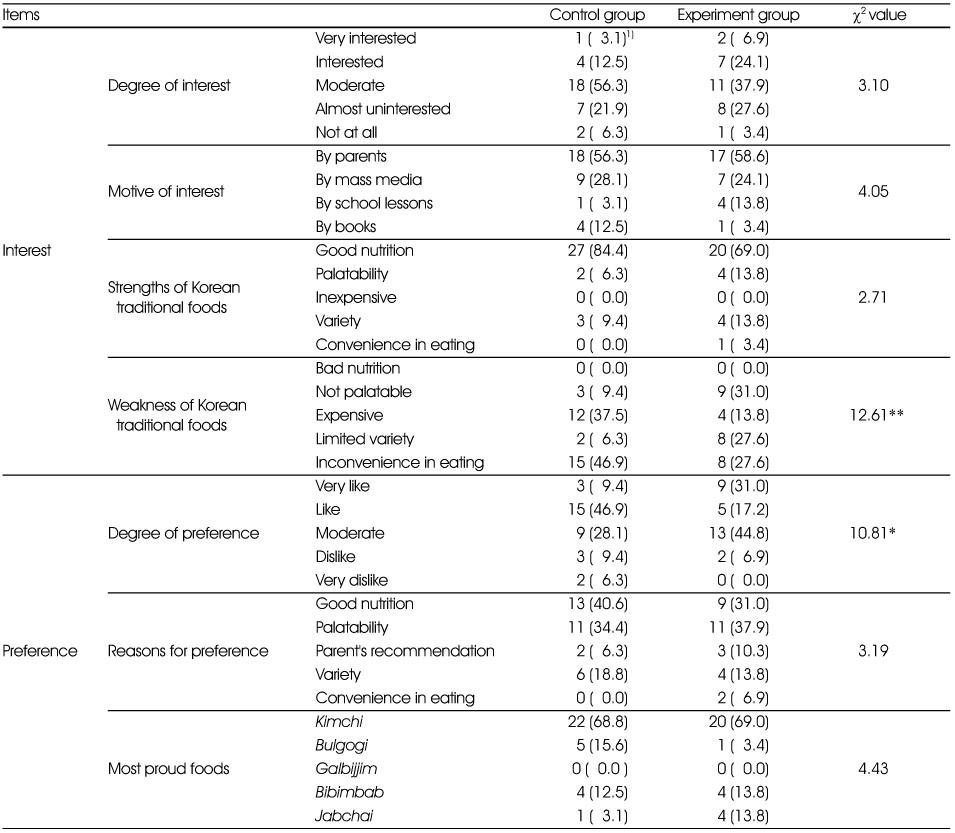
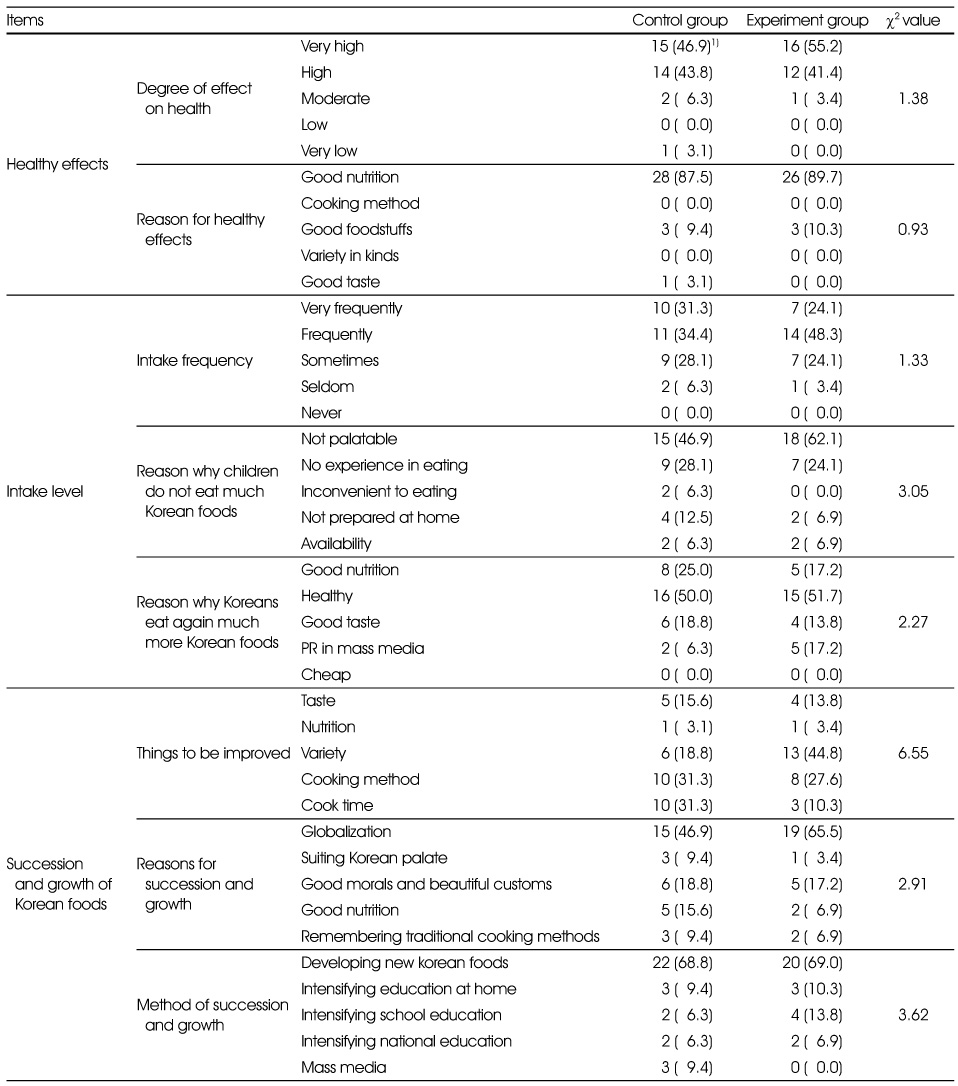
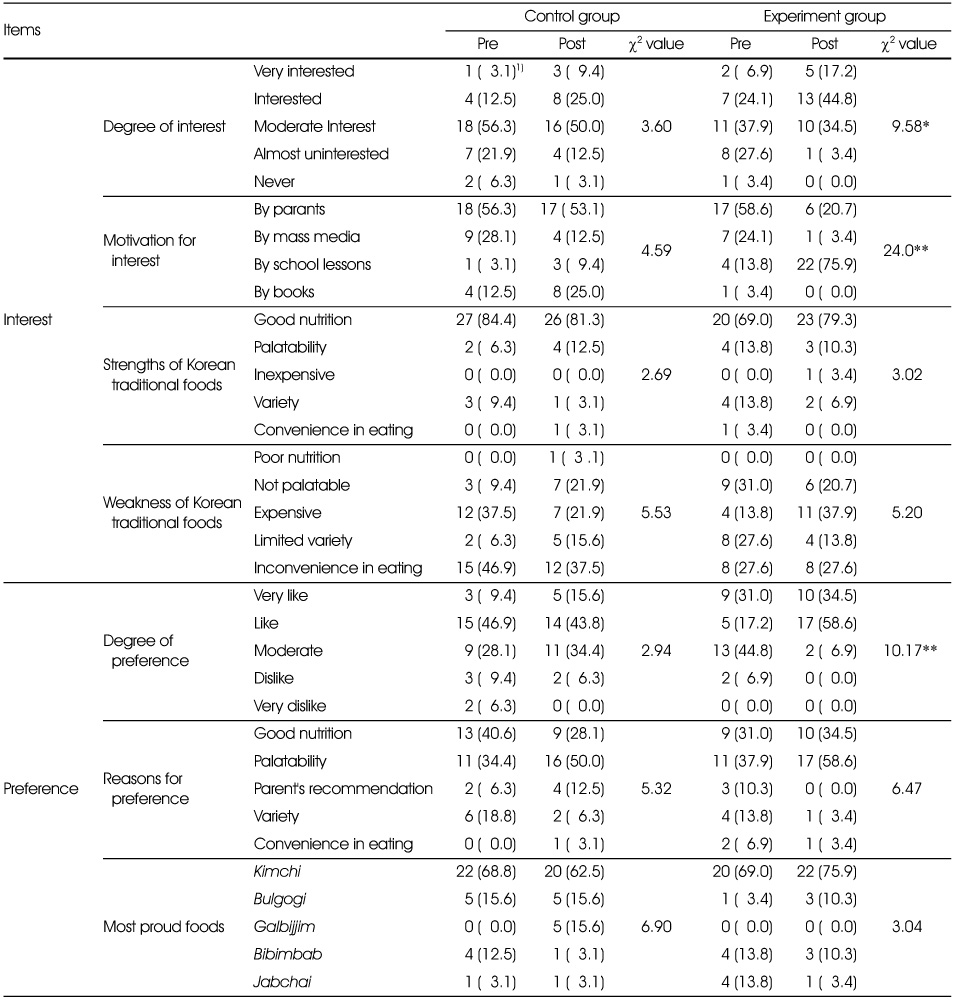
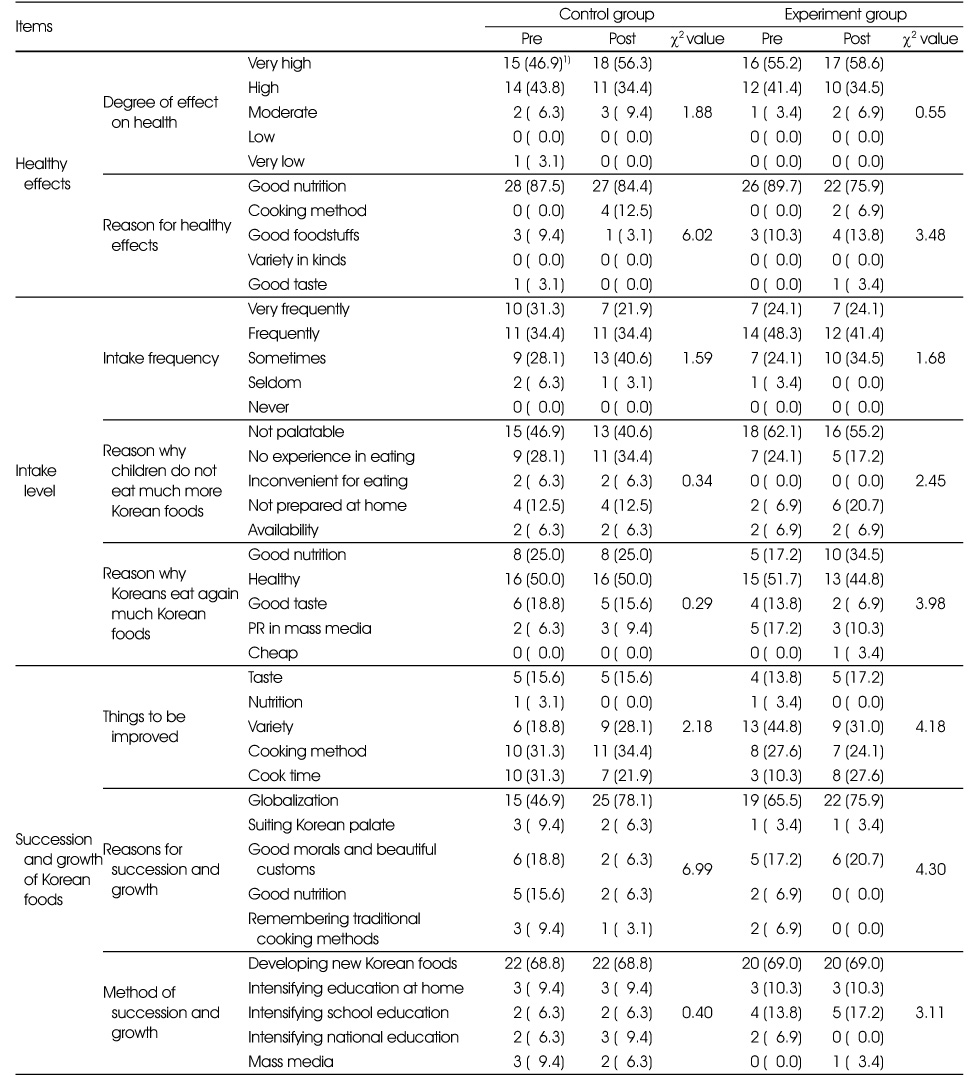
 PubReader
PubReader Cite
Cite


